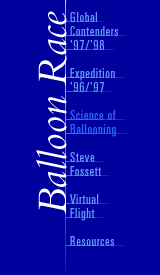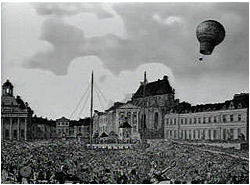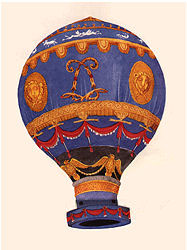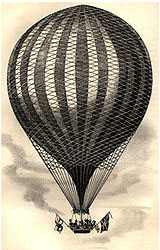|
|

|
 |
The History of Ballooning The caged duck looked down as terra firma slowly drifted
away. Above the duck, a balloon, constructed of paper and
fabric, provided the lift necessary to carry aloft the duck
and its companions, a sheep and a rooster. Never before had a
human, let alone a duck, flown in a balloon. The year was
1783, a milestone year for aviation—the dream of flying
had finally been realized. On October 15th of that year, a few
months after the duck's historic flight, a balloon, 'Aerostat
Reveillon,' launched in France, carrying scientist Pilatre De
Rozier, and rose to the end of its 250 foot tether. It stayed
aloft for fifteen minutes and then landed safely nearby. The caged duck looked down as terra firma slowly drifted
away. Above the duck, a balloon, constructed of paper and
fabric, provided the lift necessary to carry aloft the duck
and its companions, a sheep and a rooster. Never before had a
human, let alone a duck, flown in a balloon. The year was
1783, a milestone year for aviation—the dream of flying
had finally been realized. On October 15th of that year, a few
months after the duck's historic flight, a balloon, 'Aerostat
Reveillon,' launched in France, carrying scientist Pilatre De
Rozier, and rose to the end of its 250 foot tether. It stayed
aloft for fifteen minutes and then landed safely nearby.
A month later De Rozier and the Marquis d'Arlandes flew, untethered, to 500 feet and traveled about five and a half miles in a 20-minute flight, the first 'free flight' made by man. The Montgolfier-designed balloon was heated by a straw fire that eventually caused the balloon to catch on fire, but the two French brothers soon went on to design the first successful, unmanned (and unducked for that matter) balloon.  Although these early crude balloons were a far cry from
today's high-tech contraptions, the science of ballooning and
sending humans aloft had begun. In the years to follow, humans
had access to the skies like never before, and with the advent
of hydrogen ballooning, even the sky seemed to offer no limit.
What follows is a brief outline of milestones in ballooning
history: Although these early crude balloons were a far cry from
today's high-tech contraptions, the science of ballooning and
sending humans aloft had begun. In the years to follow, humans
had access to the skies like never before, and with the advent
of hydrogen ballooning, even the sky seemed to offer no limit.
What follows is a brief outline of milestones in ballooning
history:1785—The First Balloon Across the English Channel: In the early days of ballooning, crossing the English Channel is considered the first step to long distance ballooning. Pilatre de Rozier, the world's first balloonist, is killed in his attempt to cross the channel. De Rozier's experimental system consists of a hydrogen balloon and a hot air balloon tied together. Tragically, the craft explodes half an hour after takeoff. This double balloon helium/hot air system, however, remains among the most successful designs for long distance ballooning. This same year, French balloonist Jean-Pierre Blanchard and American John Jeffries become the first to fly across the English Channel.  1793—The First Balloon Flight in North America:
A 45-minute flight from Philadelphia to Gloucester County, New
Jersey is made by Jean Pierre Blanchard on January 9. George
Washington is present to see the balloon launch. 1793—The First Balloon Flight in North America:
A 45-minute flight from Philadelphia to Gloucester County, New
Jersey is made by Jean Pierre Blanchard on January 9. George
Washington is present to see the balloon launch.1794-1945—Balloons Used in Wars: From the U.S. Civil War, through World Wars I and II balloons are used as tools for warfare, for transportation surveying, and communication. Global Contenders '97/'98 | Expedition '96/'97 | Fossett | Virtual Flight Science of Ballooning | Teacher's Guide | Resources | Transcript | Balloon Home Editor's Picks | Previous Sites | Join Us/E-mail | TV/Web Schedule About NOVA | Teachers | Site Map | Shop | Jobs | Search | To print PBS Online | NOVA Online | WGBH © | Updated October 2000 |